 Promotion of petrol maps by map racks and adverts
Promotion of petrol maps by map racks and adverts
Oil company map programmes were expensive to set up and run, and could only really be justified on four grounds:
- Extra sales of fuel could be attributed to customers stopping for a map;
- The maps located service stations which customers would then seek on trips away from home;
- The maps could be sold for a small profit; or
- They made customers feel good about the brand, increasing loyalty.
Where maps have been issued in recent years, they have most commonly been by relatively new entrants into a market promoting an expanding number of locations (such as Jet in Scandinavia, or the UK hypermarkets) or in conjunction with a loyalty scheme or credit card (Belgium, for example). The continuing success of the Shell/Mairs and Aral/Busch map programmes in Germany is exceptional, with the oil company brand adding value to what is in truth a mapmaker's product range.
|
But it was not always like this. In the early years it was assumed that you could generate a real loyalty to a particular brand of petrol, and the map programme was an important part of this. However, for the promotion to work, you had to tell people that the maps were out there, and to make sure that they were seen as having a value - in excess of their modest cost, when not free. |
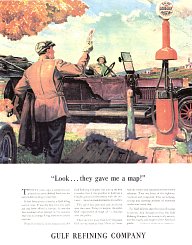 Advert courtesy of Dave Leach |
It is quite rare for maps to be advertised directly to the public in this way; they were sometimes mentioned as part of a larger touring service, or at key moments in petrol marketing. Thus Esso ran an advert promoting its maps in Britain in 1952, at the time that branded motor spirit was replacing the Pool of the wartime and postwar austerity period. Point of sales materials were at least as important, especially where maps were sold and so considered at least to some extent as a profit centre.
|
|
Both the map racks here date from the late 1950s. The Esso rack is a simple bent wire affair, with spaces for 13 regular maps (or phrase booklets) and one wider one. National's design was rigidly fixed for the 5 maps in its programme; the titles are painted onto the rack, as is the 1/- price. |
|
|
|
Companies promoted their map racks to service station customers as can be seen in these two adverts from the UK, for Esso from 1967 (left) and Mobil, as late as 1982 near the end of its map programme (right). The Esso advert still shows pre-1966 maps from the UK, as well as a selection of European maps. |
|
|
Around 1960 Esso produced a die-cut card point of sales advert, "Get Your Esso Road Maps Now". The overall display measures just 200mm tall by 230mm wide, with the Esso oil drop man (also known as "Happy") approximately 15mm proud of the main sign. |
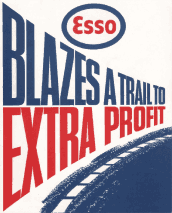 |
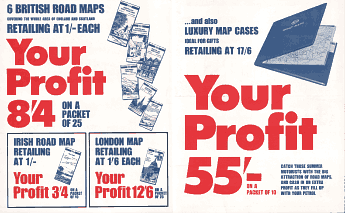 |
|
In the 1960s and 70s, many automotive companies used self-adhesive vinyl stickers to promote their products - and boys, in particular, loved plastering their school bags with these colourful adverts. (Stickers for Dunlop's Groundhog tyres were among the most popular.) Esso got into the act with this series of three designs based on nursery rhymes. Dr Foster (who fell in a puddle of rain on the way to Gloucester) is saying "Oh, for an Esso road map". A highwayman (Dick Turpin?) is asking for "Your money or your Esso road map", and Uncle Tom Cobbleigh and all are wondering "Who's got the Esso road map?" as they ride towards Widdicombe fair. Perhaps these apocryphal characters might have had a better journey with an Esso road map! |
|
|
|
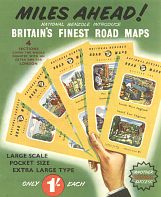
|
|
|
|
![]() National Benzole introduced its road maps in 1958, as a trend towards single brand petrol stations made maps an attractive marketing tool. The first leaflet shown here opened out to include a section of map and explanation of why National Benzole believed they were Britain's Finest Road Maps. One of the reasons was the "complete absence of heavy, black masses which so confuse built-up areas on most maps - such areas are sensibly shown in white". The leaflet also carried a panel explaining how maps are made and advised motorists to "buy them at the nearest National Benzole solus station".
National Benzole introduced its road maps in 1958, as a trend towards single brand petrol stations made maps an attractive marketing tool. The first leaflet shown here opened out to include a section of map and explanation of why National Benzole believed they were Britain's Finest Road Maps. One of the reasons was the "complete absence of heavy, black masses which so confuse built-up areas on most maps - such areas are sensibly shown in white". The leaflet also carried a panel explaining how maps are made and advised motorists to "buy them at the nearest National Benzole solus station".
National also advertised its maps in publications, with the example shown from 1961 just includes the touring maps. A second leaflet from around 1961 shows how National Benzole had expanded its range from the 5 available in the rack above to include a spiral bound atlas of 57 town plans, plus six sections of touring maps covering 25 glorious (sic) tours.
|
Esso also printed a brochure promoting its Travel Aids in the mid 1950s. It was folded to the same size as one of the sectional maps of Britain, but opened out to an eight page booklet. The first two were devoted to "The FAMOUS ROAD MAP series * millions printed to meet the demand" which were (truthfully) "amazing value at only 6d [2½p] each". Subsequent pages advertised the Norfolk Broads and Rivers map, the four continental phrase books (German, Spanish, French and Italian) and the way to obtain foreign maps through the free Esso touring service. Essentially this required collecting a postcard from any Esso forecourt attendant, filling in details of the proposed trip, and then mailing it to Paris, who could provide maps and routes in Western Europe, North Africa, the USA and Canada. |
|
|
|
|
Racks and leaflets were only of use if a customer had already entered the filling station, and failed completely in their purpose if the attendant collected payment from the driver in his car. It made more sense to advertise maps on the forecourt, sometimes on the wall or sometimes on a free-standing display unit. This National wall advert dates from 1981 and repeats the signpost used on that year's map covers. |
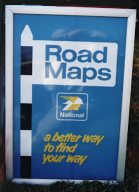
|
![]()
All original copyrights in logos and map extracts and images are acknowledged and images are included on this site for identification purposes only.
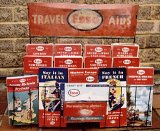
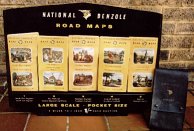
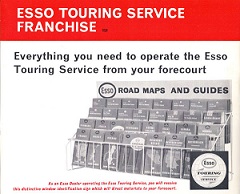
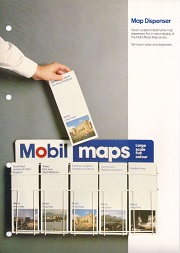
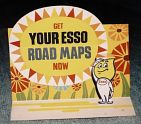
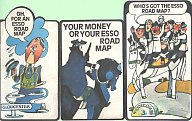



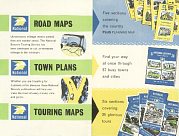
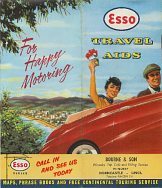
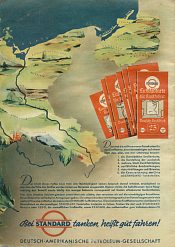
 Relatively few petrol companies used leaflets to promote maps, but German Esso was another firm to do so. Before the war, whilst still using the Standard brand, it produced an A4 atlas booklet showing German features, with the maps prominently displayed on the rear cover (shown here). Much later it promoted Esso touring services in the 1950s and 1960s through a series of Reisebrevier booklets; the adverts shown here come from the 1966 edition and show both German and European maps.
Relatively few petrol companies used leaflets to promote maps, but German Esso was another firm to do so. Before the war, whilst still using the Standard brand, it produced an A4 atlas booklet showing German features, with the maps prominently displayed on the rear cover (shown here). Much later it promoted Esso touring services in the 1950s and 1960s through a series of Reisebrevier booklets; the adverts shown here come from the 1966 edition and show both German and European maps.
